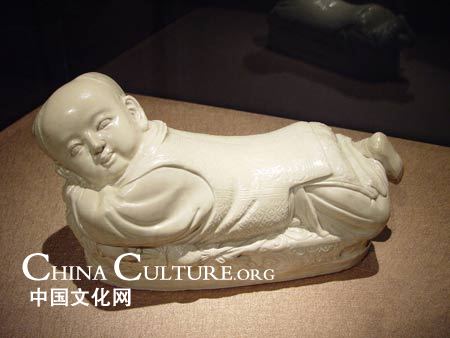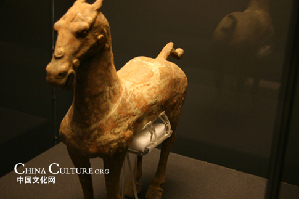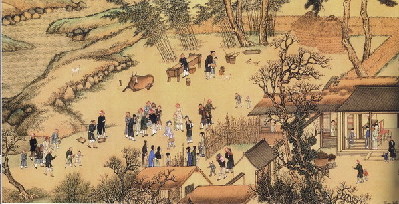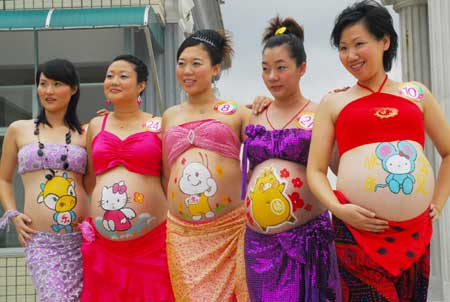| Home > Living in China > Art |
Chinese Folk Theatrical Art
Peking Opera
Peking Opera, the most popular, influential and typical opera in China, has a history of over 200 years. It highlights both singing and dancing, together with martial arts skills and fictitious
movements. In addition, its peculiar forms of singing, reciting and acting have influenced other forms of opera. The roles in Peking Opera cover male roles, female roles, "painted-face" roles and clowns. Legends and stories from history make up most of the repertoire. Famous male role actors include Tan XinPei, Yu Shuyan, Yan JuPeng, Ma Lianliang and Zhou Xinfang; and the
four most famous names in female roles are Mei Lanfang, Cheng Yanqiu, Shang Xiaoyun and Xun Huisheng.
Yueju Opera
This form of opera is popular in the region south of the Yangtze River. It originated in Zhejiang Province, the location of the ancient State of Yue, hence the name. It has a history of 70 - 80 years, starting with only narration and singing. Later, orchestra accompaniment was added. Absorbing the elements of Shaoxing Opera, it enriched them and created its own type of music. Yueju Opera is excellent at expressing emotions through singing. The tunes of Yueju Opera are pure, sweet and agreeable, and the performance is vivid and moving, with the rich folk flavor of this region. Famous actresses include Yuan Xuefen, Fu Quanxiang, Fan Ruijuan, Xu Yulan and Whng Winjtian.
Hebei Bangzi (Wooden Clapper) Opera
This is the main type of drama in Hebei Province. In the past it was called Jing Wooden Clapper Opera, Zhili Wooden Clapper Opera and Wei (referring to Tianjnwei ) Wooden Clapper Opera
before it became He bei Wooden Clapper Opera in l952. It is popular in Beijing, Tianjin, Hebei, Jilin, Liaoning, Heilongiiang, Inner Mongolia and Shandong. It developed from Shaanxi Opera and Shanxi Wooden Clapper Opera, which were introduced into Hebei in the middle of the Qing Dynasty. The singing and narration and based on the Beijing dialects, and the classification of the roles and the performance forms are quite similar to those of Peking Opera.
Huangmei Opera
This is the local drama style of Anhui Province, and was called Huangmei Tune or Caicha Opera in the past. It developed from folk songs and dances, and is popular in Anhui, Jiangxi and Hubei
Provinces. Its tunes maintain the flavor of folk songs, graceful and sweet-sounding. Famous actors and actresses include Yan Fengying, Wang Shaofang and Pan Jingi.
Hunan Flower-drum Opera
This is the general name for all the local flower-drum operas and lantern operas in Hunan Province. They are divided into Chaopha Flower-drum Opera, Hengyang Flower-drum Opera,
Shaoyang Flower-drum Opera, and others, which have different styles. The Hunan Flower-drum Opera developed from Hunan folk songs, and from one female role and a clown role to three singing roles. There are about 400 plays in the flower-drum repertoire, and over 300 tunes. These plays can be divided, according to their structure and musical style, into Sichuan Tune, Daluo Tune, Paiziand Xiaodiao. They all feature straightforward melodies and rich folk flavor. The famous actors include Liao Chunshan, Wang Yousheng and Zhang Shushen.
Fangshan Drum Dance
Also called "Sparrow Skipping", this folk dance originated in Fanghan, Jiangning District, Nanjing City. The dance imitates the movements of a sparrow, such as spreading its wings, pecking at
grains, sitting on eggs and so on. The number of instruments has increased to l2 drums, l2 gongs and l0 cymhals. Colored flags accompany the Fanghan Drum Dance, making the scene more majestic
Kunqu Opera
This opera is popular in Kunshan, Jiangu Province, and has a history of over 500 years. It has a large repertoire, pure and sweet melodies and attractive actions. The bamboo flute is the main
instrument in the orchestra, together with the xiao (vertical bamboo flute), sheng (a reed instrument), pipe and other instruments. Its tunes and dances have influenced other types of opera. Kunqu Opera is div
Art
 more
moreClassic Chinese Handicraft:
Porcelain pillows, as classic Chinese handicraft,

Chinese Treasures Returned from
As witness of Chinese culture and custom, countless treasures

The lost legacy: classical music
Accompany by the long history of China, Chinese classical music

Customs
 more
moreChinese Kungfu
Kungfu Taste: Learn Martial Art in Shaolin Temple
The mention of Shaolin Temple conjures up images of a quiet and
Keet Kune Do will reappears on screen: BRUCE Lee and
The Legend of Bruce Lee is shot by China Central Television
The Road to the Olympic Games for Wushu
Wushu, also called kungfu, martial arts, is attracting more and more




 print
print  email
email  Favorite
Favorite  Transtlate
Transtlate 
